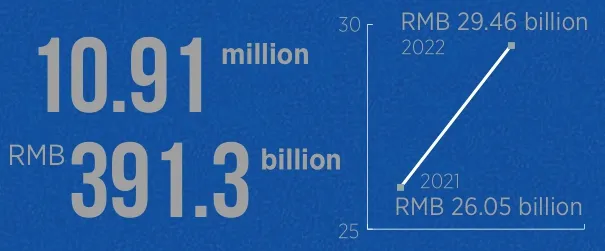A ‘GOLD STAR’ ON CHINA’S ECONOMIC LANDSCAPE
2022-06-23ByShenXiaoning
By Shen Xiaoning
Driven by the RCEP,the Greater Bay Area has become one of the most open and economically dynamic regions of China and a fountainhead of development opportunities for Southeast Asian enterprises
O n July 1,2017,Chinese President Xi Jinping witnessed the signing of the Framework Agreement on Deepening Guangdong-Hong Kong-Macao Cooperation in the Development of the Greater Bay Area (GBA) among the governments of Guangdong Province,Hong Kong Special Administrative Region (SAR) and Macao SAR.Construction of the GBA started based on“one country,two systems,three customs territories,and three currencies,”and was planned to cover nine cities in Guangdong,including Guangzhou and Shenzhen,as well as the Hong Kong and Macao SARs.
Since then,a world-class bay area and city cluster has been under construction across about 56,000 square kilometers.It is not only a national strategy of China’s reform and opening-up in the new era,but also a pioneering exploration of regional economic development at a global scale.
Blazing a New Trail
Innovation is key to the success of the GBA.On November 12,2018,President Xi commented on the construction of the GBA during a meeting with a Hong Kong-Macao delegation visiting Beijing to participate in celebrations for the 40th anniversary of reform and opening-up.“We will continue to encourage bold trials and experiments to blaze a new trail in this effort,”he said.
During an inspection tour of Guangdong in October 2020,Xi gave further instructions on achieving innovative breakthroughs in the construction of the GBA,urging the province to“advance reform and opening-up with greater courage and from a higher starting point”and“strive to take the lead in the country and create new splendor on the new journey of building a modern socialist country in all respects.”
During construction of the GBA,Guangdong Province has launched several major projects.In October 2020,Shenzhen began to implement a comprehensive pilot reform plan.More than half of 40 tasks on the first list have been accomplished.As of July 2021,Guangzhou had adopted the 144-hour(6 days) transit visa exemption policy for foreign travelers at Baiyun Airport,and 24/7,year-round customs clearance for imports and exports was available at Nansha,Huangpu,and other ports.

China’s imports and exports with the other 14 RCEP member states in the first quarter of this year increased by6.9 percentover the same period last year,accounting for30.4 percentof China’s total foreign trade in the same period.

Shenzhen’s Yantian Port is a world-class shipping hub in the GBA.In the first quarter of this year,the import and export throughput of the port was about10.91 milliontons,worth391.3 billion yuan (US$60.2 billion),29.46 billion yuan(US$4.53 billion) of which were throughput with RCEP countries,up 13.1 percent year on year.

Skyline of the Guangdong-Macao in-depth cooperation zone in Hengqin,Zhuhai,Guangdong Province.(VCG)
On October 16,2021,27 hours of continuous work left nearly half of the underwater tunnel of the Shenzhen-Zhongshan Cross-Sea Passage installed.The 24-kilometer-long passage,scheduled to open to traffic in 2024,is another mega project of the GBA after the Hong Kong-Zhuhai-Macao Bridge and the Guangzhou-Shenzhen-Hong Kong High-Speed Railway.Its opening will cut the drive time from Shenzhen to Zhongshan down to only 30 minutes,which will upgrade the GBA’s current“one-hour living circle”to a“halfhour living circle,”further enhancing convenient transportation in the area.
“As the vanguard of the country’s reform and opening-up,Guangdong is accelerating construction of a platform for deepening reform comprehensively and providing strategic support for the new development paradigm,”commented Chen Guanghan,chief expert at the Institute of Guangdong,Hong Kong,and Macao Development Studies at Sun Yat-sen University.
The Guangdong-Macao in-depth cooperation zone in Hengqin,an island located in the city of Zhuhai,Guangdong Province,covers about 106 square kilometers.So far,the zone has incubated more than 600 innovation and entrepreneurship projects from Macao and built a demonstration base with the University of Macau and the Macau University of Science and Technology to congregate enterprises,universities,and research institutes.All four key state laboratories in Macao have set up branches in the zone.
Ho Iat Seng,chief executive of the Macao SAR,said in his Policy Address for the Fiscal Year 2021 to the Legislative Assembly that Macao would follow the central government’s plan to build an in-depth cooperation zone with an open and innovative mind to optimize the advantages of“one country,two systems,”comply with international rules,promote diversification of Macao’s economy,and serve the country’s opening-up.
In her Policy Address at the Legislative Council in October 2021,Carrie Lam Cheng Yuet-ngor,chief executive of the Hong Kong SAR,introduced a proposal to develop Hong Kong’s northern part into a Northern Metropolis to share the fruits of complementarity in the respective strengths of Hong Kong and Shenzhen as well as their integrated development.This Northern Metropolis would be developed as an international I&T hub with a unique metropolitan landscape marked with“Urban-Rural Integration and Co-existence of Development and Conservation,”while the Harbour Metropolis supporting Hong Kong’s status as an international financial center would be expanded to include the reclaimed land of the Kau Yi Chau Artificial Islands under the Lantau Tomorrow Vision.The twin downtowns in the north and south of Hong Kong would provide massive land and enhance the spatial layout of Hong Kong.These two metropolises,spearheading their respective economic engines and complementing each other,will likely drive the future development of Hong Kong.
“The project sends a strong signal that Hong Kong will be integrated into the overall development of the country,”commented Liang Haiming,Hong Kong economist and president of the China Silk Road iValley Research Institute.
Connecting GBA with RCEP
According to statistics from China’s General Administration of Customs,since the entry into force of the Regional Comprehensive Economic Partnership(RCEP) agreement at the beginning of this year,China’s imports and exports with the other 14 RCEP member states in the first quarter of this year increased by 6.9 percent over the same period last year,accounting for 30.4 percent of China’s total foreign trade in the same period.
Before the agreement came into effect,the GBA already began to pinpoint its position in the RCEP framework.On November 30,2021,the 2021 GBA Conference took place in Hong Kong,themed“Embracing New Opportunities:Connecting GBA with RCEP.”It aimed to explore RCEP business opportunities for the GBA.Leung Chunying,vice-chairman of the National Committee of the Chinese People’s Political Consultative Conference(CPPCC) and chief convener of the Hong Kong Coalition,founded in May 2020 to“get Hong Kong start again,”said at the conference that the signing of the RCEP agreement would bring Hong Kong a new growth engine to facilitate cooperation with mainland cities in the GBA.“As one of the largest global trade hubs for both goods and services,Hong Kong deserves a reputation as a ‘super connector’,”he said.
Statistics show that after the RCEP agreement came into effect,Hong Kong’s trade in goods and services with relevant countries accounted for nearly 60 percent of its total foreign trade.Hong Kong also formally applied to join the RCEP in February of this year.
“Joining the RCEP will inject new impetus into Hong Kong’s foreign trade and cooperation,”said Victor Fung,chairman of the Hong Kongheadquartered Fung Group and member of the board of the Boao Forum for Asia(BFA),at the BFA annual conference on April 20.“As a regional financial center and trade center,Hong Kong can play a coordinating and integrating role in serving the greater economy,”said Fung.
As an important piece of the GBA,Guangdong has also shared the“RCEP dividend”in terms of highquality opening-up.In less than a month after the agreement came into effect,the provincial customs issued a total of 22,000 RCEP certificates of origin,which has not only helped Chinese enterprises enjoy import tariff reductions of US$430,000,but also facilitated entry of foreign products into the Chinese market.
At the foreign trade ports in Guangdong,a vast array of“made in China”chemical coatings,electronic products,clothing and leather goods,sports equipment,seasonings,food and daily necessities were ready for shipment to other RCEP countries.At the same time,Japanese electrical appliances,New Zealand beef and mutton,Southeast Asian fruits and spices were being unloaded for the Chinese market with significant tariff reductions.
“In the past,we could only apply for the general certificate of origin to export our products to Japan and didn’t get any tariff concessions,”said Xiao,section chief of customs clearance at the Zhuhai Hongchang Electronic Materials Company.“Now,the RCEP certificate gets us a more than 3 percent tariff reduction,which is really helping our company expand in the Japanese market.”
“Driven by the RCEP,the GBA,one of the most open and economically dynamic regions in China,will provide greater development opportunities for more international enterprises,especially those in Southeast Asia.”
Panasonic Motor Zhuhai Company was the first Japanese-invested enterprise to obtain RCEP preferential certificate of origin in Zhuhai.“Imports and exports are mutually complementary,”said Nie Fangming,head of the company’s import and export division.“Relevant arrangements have strengthened economic cooperation among East Asian countries,which will help businesses reduce their operating expenses as much as possible.”
Shenzhen’s Yantian Port is a worldclass shipping hub in the GBA.In the first quarter of this year,the import and export throughput of the port was about 10.91 million tons,worth 391.3 billion yuan (US$60.2 billion),29.46 billion yuan (US$4.53 billion) of which were throughput with RCEP countries,up 13.1 percent year on year.On March 23,Yantian Port’s first direct shipping line to Cebu Port in the Philippines opened.It was the second Southeast Asian shipping line opened by Yantian Port after the RCEP agreement came into effect.So far,the port has opened 23 shipping lines to RCEP countries.
The GBA,almost at the geographic center of the RCEP region,is blessed with natural advantages in terms of connecting China with ASEAN countries as well as Japan,South Korea,Australia,and New Zealand.This allows the area to become a RCEP regional logistics distribution center,making local cities more attractive in terms of trade and logistics.
Surbana Jurong Private Limited (SJ),a Singapore-based multidisciplinary urban,infrastructure and management services consultancy firm,is one of Asia’s largest firms of its kind.It has“taken root”in China for nearly 30 years.Two years ago,SJ opened an office in Shenzhen.Lim Hong Kian,CEO of SJ North Asia,said that his company made the strategic move mainly because Shenzhen is one of the main engines of economic development in the GBA thanks to its perfect policy supporting mechanisms and a big pool of talent.After the entry into force of the RCEP agreement,Lim is more confident.“Driven by the RCEP,the GBA,one of the most open and economically dynamic regions in China,will provide greater development opportunities for more international enterprises,especially those in Southeast Asia,”he said.
Looking to the future of the GBA,Cao Jinli,director of the Taiwan,Hong Kong and Macao Research Institute at the Chinese Academy of International Trade and Economic Cooperation under the Ministry of Commerce,thinks that the GBA will continue to optimize the international market layout and accelerate balanced development of imports and exports.She suggested the GBA seize the opportunities created by the RCEP and continue to tap the potential of traditional markets such as ASEAN,Japan,and South Korea,leverage Macao’s advantages in exploring new markets with Portuguesespeaking countries,explore business opportunities with the launch of the African Continental Free Trade Area(AfCFTA),and deepen trade cooperation with Latin American countries.
After only half a year since the RCEP agreement came into effect,construction of the GBA has been so encouraging that expectations are high for its future.Many are now looking to the continuous development of China’s high-quality opening-up and the GBA to bring more pleasant surprises to Asia and the world.
